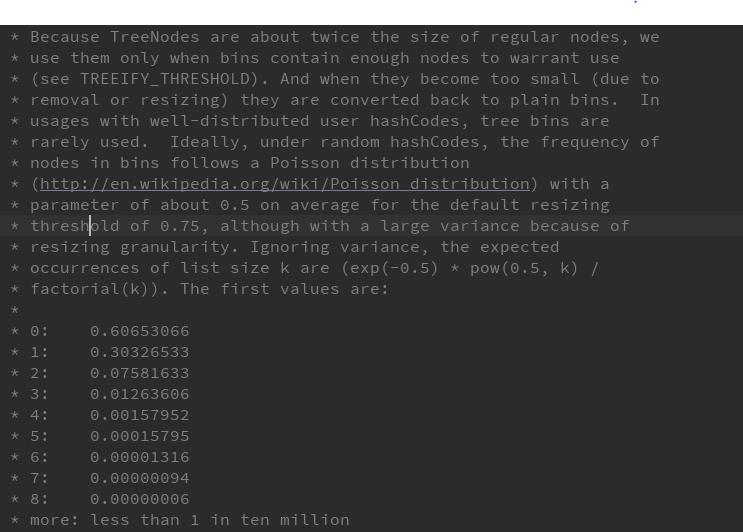1.hashMap中的成员分析
transient Node<K,V>[] table; //为hash桶的数量 /** * The number of key-value mappings contained in this map. */ transient int size; //hashMap中键值对的数量 /** * The number of times this HashMap has been structurally modified * Structural modifications are those that change the number of mappings in * the HashMap or otherwise modify its internal structure (e.g., * rehash). This field is used to make iterators on Collection-views of * the HashMap fail-fast. (See ConcurrentModificationException). */ transient int modCount; //用来记录hashMap被改变的次数,进行fail-fast /** * The next size value at which to resize (capacity * load factor). * * @serial */ // (The javadoc description is true upon serialization. // Additionally, if the table array has not been allocated, this // field holds the initial array capacity, or zero signifying // DEFAULT_INITIAL_CAPACITY.) int threshold; //用来表示HashMap的阙值 threshold = capacity*loadFactor /** * The load factor for the hash table. * * @serial */ final float loadFactor; //用来表示HashMap的加载因子
2.hashMap中的重要方法分析
(1).hash方法(用来根据key来获取hash值)
static final int hash(Object key) { int h; return (key == null) ? 0 : (h = key.hashCode()) ^ (h >>> 16); //注意当key为null是会返回0,hashmap允许key为null进行存储,且存在table[0]的位置。
另外会对获取的hashcode进行高低16位按位与,减小hash冲突的概率 }
(2).tableSizeFor(使用此方法来让我们的容量变为2的倍数)
static final int tableSizeFor(int cap) { int n = cap - 1; n |= n >>> 1; n |= n >>> 2; n |= n >>> 4; n |= n >>> 8; n |= n >>> 16; return (n < 0) ? 1 : (n >= MAXIMUM_CAPACITY) ? MAXIMUM_CAPACITY : n + 1; }
(3).put方法
public V put(K key, V value) { return putVal(hash(key), key, value, false, true); //会去调用putVal方法 }
final V putVal(int hash, K key, V value, boolean onlyIfAbsent, boolean evict) { Node<K,V>[] tab; Node<K,V> p; int n, i; if ((tab = table) == null || (n = tab.length) == 0) //判断table是否为null或table的大小是否为0 n = (tab = resize()).length; //如果上述条件成立,那么调用resize()方法去扩容 if ((p = tab[i = (n - 1) & hash]) == null) //计算插入的元素在hash桶中的位置,若该位置还没有元素 tab[i] = newNode(hash, key, value, null); //新建一个node节点,并将该节点添加到该位置 else { //否则,执行以下代码 Node<K,V> e; K k; if (p.hash == hash && //判断该位置的第一个元素是否与我们要插入的元素相同 ((k = p.key) == key || (key != null && key.equals(k)))) e = p; //如果相同则记录该节点到变量e else if (p instanceof TreeNode) //否则判断第一个节点是否为树类型的节点 e = ((TreeNode<K,V>)p).putTreeVal(this, tab, hash, key, value); //如果是,则调用树类型的插入操作 else { //否则,第一个元素既不与我们要插入的节点相同,又不是树类型的节点,那么去遍历链表 for (int binCount = 0; ; ++binCount) { if ((e = p.next) == null) { //若节点为空则表示已经遍历到链表的最后,此时新建一个节点并加入到末尾 p.next = newNode(hash, key, value, null); if (binCount >= TREEIFY_THRESHOLD - 1) // -1 for 1st //判断链表的长度是否大于8 treeifyBin(tab, hash); //将链表转为红黑树 break; } if (e.hash == hash && ((k = e.key) == key || (key != null && key.equals(k)))) //如果某个节点与我们即将插入的节点相同,则跳出循环 break; p = e; } } if (e != null) { // existing mapping for key //此时e节点中记录的是hashMap中与我们要插入的节点相同的节点,在这里统一进行处理 V oldValue = e.value; //记录旧的value值 if (!onlyIfAbsent || oldValue == null) //通过onlyIfAbsent与oldValue的值判断是否要进行覆盖 e.value = value; //覆盖旧的值 afterNodeAccess(e); //此方法与LinkedHashMap相关,是一个回调方法,我们之后的文章再进行分析 return oldValue; //返回旧的值 } } ++modCount; //代表hashMap的结构被改变 if (++size > threshold) //判断是否要进行扩容 resize(); afterNodeInsertion(evict); //此方法也是与LinkedHashMap相关的方法 return null; }
(4).resize(用来对hashMap进行扩容)
final Node<K,V>[] resize() { Node<K,V>[] oldTab = table; //记录原来的table int oldCap = (oldTab == null) ? 0 : oldTab.length; //判断原来的table是否为空,若为空则oldCap = 0,否则oldCap = oldTab.length int oldThr = threshold; //记录原来的阙值 int newCap, newThr = 0; //创建变量用来记录新的容量和阙值 if (oldCap > 0) { //判断原来的容量是否大于0,由于HashMap是在第一次put是才会进行初始化,因此此方法也是判断table是要扩容还是要初始化.大于0代表已经初始化过了 if (oldCap >= MAXIMUM_CAPACITY) { //如果原来的容量大于0且大于等于最大值 threshold = Integer.MAX_VALUE; //将阙值设为最大值,并返回原来的容量,代表该table已经不能再进行扩容 return oldTab; } else if ((newCap = oldCap << 1) < MAXIMUM_CAPACITY && oldCap >= DEFAULT_INITIAL_CAPACITY) newThr = oldThr << 1; // double threshold //新的阙值为原来阙值的一倍 } else if (oldThr > 0) // initial capacity was placed in threshold //如果说oldCap为0(代表hashMap没有被初始化过)且原来的阙值大于0(此处需要看一下hashmap的构造方法) newCap = oldThr; //将新的容量设置为原来的阙值 else { // zero initial threshold signifies using defaults//否则说明我们在新建hashMap是没有指定初始值或是我们将初始大小设为了0 newCap = DEFAULT_INITIAL_CAPACITY; //设为默认值16 newThr = (int)(DEFAULT_LOAD_FACTOR * DEFAULT_INITIAL_CAPACITY); //阙值设为16*0.75 } if (newThr == 0) { //如果新的阙值为0(此处表示在新建hashMap是给定了capacity且不为0) float ft = (float)newCap * loadFactor; //设置为newCap*loadFactor或是最大值 newThr = (newCap < MAXIMUM_CAPACITY && ft < (float)MAXIMUM_CAPACITY ? (int)ft : Integer.MAX_VALUE); } threshold = newThr; //设置当前的阙值为新的阙值 @SuppressWarnings({"rawtypes","unchecked"}) Node<K,V>[] newTab = (Node<K,V>[])new Node[newCap]; //以新的容量去新建一个table数组(可能是初始化,也可能是扩容) table = newTab; if (oldTab != null) { //若原来的table是否为空,代表现在是要进行扩容操作 for (int j = 0; j < oldCap; ++j) { //遍历hash桶 Node<K,V> e; if ((e = oldTab[j]) != null) { //遍历每一个hash桶中的元素,并记录第一个节点到变量e oldTab[j] = null; //将原来的位置设为null if (e.next == null) //如果只有一个元素 newTab[e.hash & (newCap - 1)] = e; //计算新的位置,并插入 else if (e instanceof TreeNode) //如果是树节点,则转为红黑树的扩容操作 ((TreeNode<K,V>)e).split(this, newTab, j, oldCap); else { // preserve order Node<K,V> loHead = null, loTail = null; //将每一个桶中的元素分为两类,扩容后的位置与原来相同则记录到loHead,loTail这个链表中,扩容后与原来的位置不同则记录到hiHead,hiTail中 Node<K,V> hiHead = null, hiTail = null; Node<K,V> next; do { next = e.next; if ((e.hash & oldCap) == 0) { if (loTail == null) loHead = e; else loTail.next = e; loTail = e; } else { if (hiTail == null) hiHead = e; else hiTail.next = e; hiTail = e; } } while ((e = next) != null); if (loTail != null) { loTail.next = null; newTab[j] = loHead; //将loHead链表写入到新的table } if (hiTail != null) { //将hiHead链表记录到新的table hiTail.next = null; newTab[j + oldCap] = hiHead; } } } } } return newTab; }
3.hashMap中的一些细节问题
(1).为什么table的大小为2的倍数,且以2倍进行扩容?
① 在传统的散列中我们一般使用奇数作为table的长度,由于奇数的因子只有1与本身,在进行取余操作时可以避免hash冲突的概率。但是当我们在进行resize操作时需要去一个个的去计算新的位置。
② 当我们以二倍扩容后,我们发现每次扩容后只是hashCode多长来了一位计算为,我们只需要去判断多出来的计算位是1 or 0 就可以判断新的位置不变还是在(oldCap+OldPos)的位置。
(2).为什么在链表节点大于8是转换为红黑树?(参考源码中的注释)
